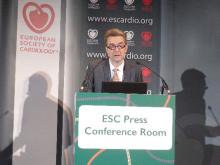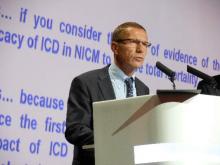ROME – Implantable cardioverter-defibrillators failed to significantly cut total mortality in patients with nonischemic systolic heart failure in the first large, randomized trial designed specifically to test the treatment in this setting. But the devices did show significant efficacy for doing what thy are specifically designed to do: prevent sudden cardiac death.
Results from the Danish Study to Assess the Efficacy of ICDs in Patients with Non-ischemic Systolic Heart Failure on Mortality (DANISH) also highlighted the importance of targeting implantable cardioverter-defibrillator (ICD) treatment to the patients with nonischemic systolic heart failure who are most likely to benefit from it, younger patients who can be expected to live substantially longer than 1 year after they receive the device.
As a consequence, although the DANISH outcome was neutral for the study’s primary endpoint of decreased all-cause mortality several experts who commented on the findings as well as its lead investigator saw the overall results as providing important new evidence that ICDs are beneficial as long as they get placed in relative young nonischemic heart failure patients who don’t have comorbidities that threaten a quick demise.
The DANISH results “tell us ICDs can benefit patients if we can be a little better in selecting the right patients,” said Lars Køber, MD, while presenting the results at the annual congress of the European Society of Cardiology.
He noted that “for us [in Denmark] the results actually mean we’ll implant more ICDs. We had not been using ICDs [in patients with nonischemic systolic heart failure] because we were not convinced we should use them on everyone,” said Dr. Køber, a professor of cardiology at the University of Copenhagen.
“The primary outcome was neutral, but the reduction in sudden cardiac death, the primary objective of an ICD, was significant, so placing an ICD should be taken into consideration,” commented Michel Komajda, MD, professor of cardiology at Pierre and Marie Curie University in Paris.
“This is the first trial to look at ICDs in the setting of modern therapy. Most of the ICD trials are very old now,” commented Mariell L. Jessup, MD, a heart failure specialist and professor of medicine at the University of Pennsylvania in Philadelphia. “In DANISH the ICDs significantly reduced the incidence of sudden cardiac death; that is what ICDs do.”
DANISH randomized 1,116 patients with nonischemic systolic heart failure at any of five Danish hospitals to either receive or not receive an ICD on top of optimal medical therapy and, when judged appropriate, placement of a cardiac resynchronization therapy (CRT) device. The patients averaged about 64 years of age, they all had New York Heart Association class II or III heart failure, and their maximum left ventricular ejection fraction was 35%. The researchers followed patients for a median of about 68 months (5.7 years).
The study’s primary endpoint, death from any cause, occurred in 22% of the ICD recipients and in 23% of control patients, a nonsignificant difference. The two prespecified secondary endpoints were cardiovascular death, which was a relative 23% lower in the ICD patients and also not statistically significant, but the rate of sudden cardiac death during follow-up was 4% in the ICD patients and 8% in the controls, a statistically significant 50% relative risk reduction. Concurrent with Dr. Køber’s report of these results at the meeting they also appeared online (N Engl J Med. 2016 Aug 28;doi: 10.1056/NEJMoa1608029).
The study design also included a set of prespecified subset analyses, and one of these showed a statistically significant interaction: When the analysis stratified patients into tertiles by age, those younger than 59 years old had a statistically significant 49% cut in all-cause mortality with ICD use, and patients 59-67 years old had a nonsignificant 25% reduction in all cause mortality when on ICD treatment. A second analysis that included all these patients less than 68 years old showed that ICD use linked with a statistically significant 36% relative cut in all-cause death, compared with the patients who did not receive an ICD. Older patients, those at least age 68 years, had a relative 20% increased rate of all-cause mortality with ICD use but not a statistically significant difference.
The results also showed a downside to ICD use. Among the 42% of patients who did not receive a CRT device, the rate of serious infection was 2.6% in the ICD recipients and 0.8% in the control. Serious infection rates with and without ICD placement were similar in the subgroup of patients who received a CRT device.



